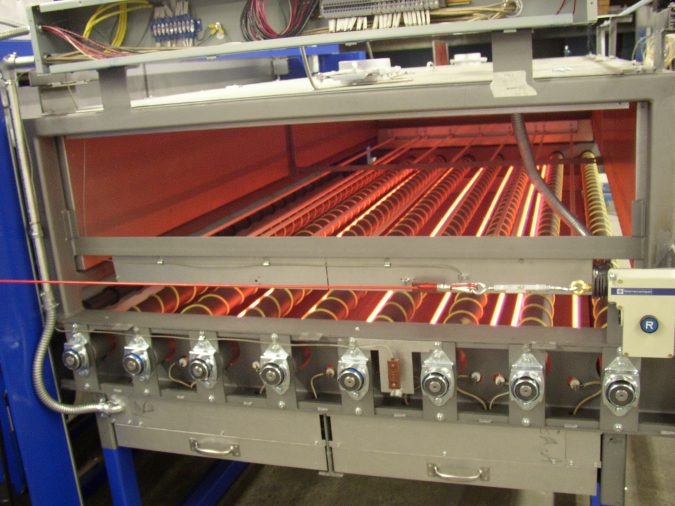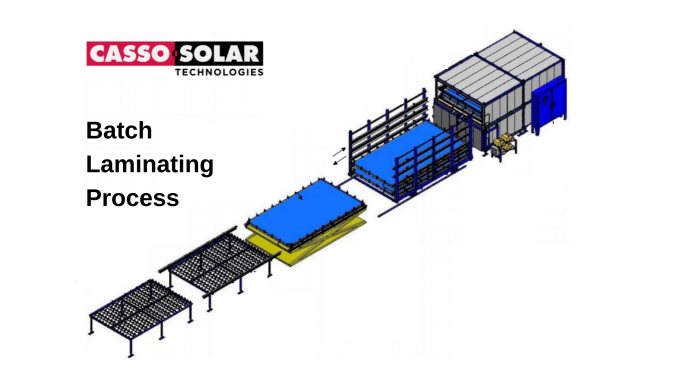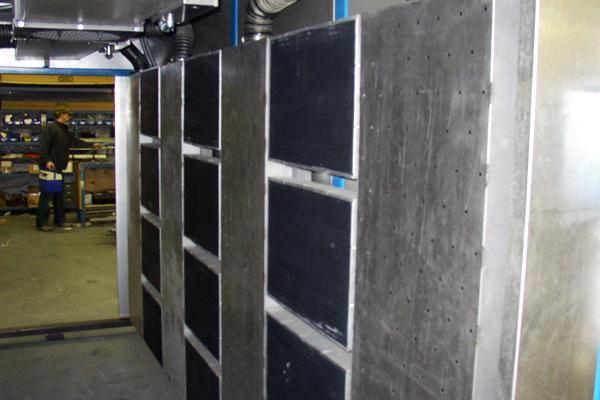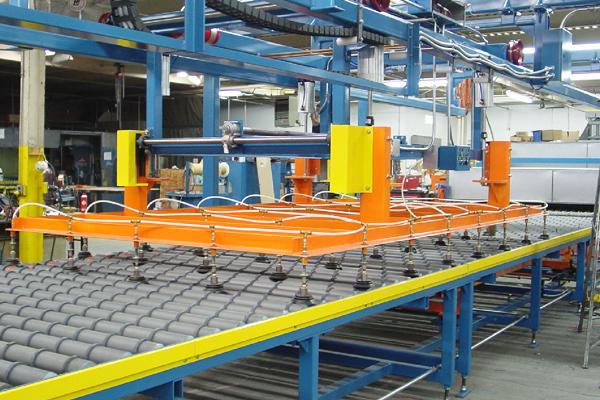
Specializing in Industrial Infrared Ovens, Furnaces, Dryers - Over 60 Years of Excellence at Casso Solar Technologies
Read our expert blog posts about the latest advancements in infrared heating technology applications used in manufacturing equipment such as industrial ovens, furnaces, heaters, and dryers.



A Guide to Laminated Glass Production Using SentryGlas®
Discover how SentryGlas® interlayers revolutionize laminated glass production with superior strength, clarity, and design possibilities, and equipment solution insights from Casso-Solar.

How To Select an Infrared Heater for Heat Processing Applications
From glass manufacturing to textile production, companies utilize heat during their manufacturing process. This heat often is supplied in the form of convection: a process that works on the easy-to-understand principle of using hot air to heat an object. Another commonly used method is infrared heating. It uses energy in the electromagnetic spectrum to directly provide heat to an object. The principles behind it are somewhat more complex.

Understanding Infrared Heater Control: A Guide to Components and Optimization
This post offers an in-depth look at infrared heater control, covering the critical components of a control circuit: temperature measurement devices, temperature controllers, and power controllers. It delves into their functions, differences, and how to effectively utilize them for optimal heating performance.

Short vs. Medium Wave IR Heating: Which One Is Right for Your Manufacturing Process?
Manufacturing cycles often require heat to process materials and produce finished goods. Many manufacturers turn to infrared (IR) heating processes to provide energy-efficient, high-intensity heat for various drying applications. More than 60 years ago, Casso-Solar Technologies started out as a simple infrared heaters manufacturer. Since then, we’ve continually developed our products to meet the complex, custom specifications of our clients’ projects.

Electrochromic Glass Production with a Rolling Hearth Furnace
There are a number of companies developing new techniques and processes for producing electrochromic glass (glass that tints when an electric current is applied) and in many cases those processes require the glass to be raised to an elevated temperature (500°C+) for a set period of time, then annealed and cooled. A rolling hearth furnace can be supplied with all of the necessary features to produce the glass in a single piece of equipment.

Glass Lamination Systems
Laminated glass is a high value-added product that more and more companies are moving to producing in-house rather than relying on out-sourcing. The addition of laminated glass production for any company is a major investment, so it is critical to ensure when purchasing equipment that it is designed to produce the products a company wishes to sell, while also being cost-effective to operate.

An Overview of Glass Batch Lamination Using Vacuum Batch Lamination Oven
Laminated glass is used in various structural and architectural applications to provide additional durability, versatility, and strength when compared to monolithic glass. Laminated glass is constructed of two or more sheets of glass, which are held together using an interlayer material such as polyvinyl butyral (PVB) or ethylene vinyl acetate (EVA).

Why Infrared Quartz Heaters are More Efficient than Ceramic Heaters?
Infrared quartz heaters are popular today in many industrial heating applications. However, quartz is not the only material commonly used to construct infrared heaters. Often, ceramic is utilized as the base material in infrared heaters, but it produces less efficient heaters than when quartz is used as the base material.

Casso-Solar Technologies wins USGlass Readers’ Choice Award 2020
Casso-Solar Technologies has won the 2020 USGlass Readers’ Choice Award in the Machinery, Lamination Equipment Category. The winners of the USGlass Readers’ Choice Award are chosen by the readers of USGlass magazine.

Comparison of Convection and IR Drying and Curing Systems
Manufacturers across the globe utilize a number of different types of heating to accomplish drying and curing tasks, but the two most common types are convection and infrared.

Know the Industrial Applications and Benefits of Infrared Heaters
There are numerous industrial processes that use heating, and many of those applications are well-suited to using infrared. These range from simple drying processes to more complex forming processes and beyond.

Quartz in Infrared Heater Design: Why Is It Used and How Does It Work?
Historically, many infrared heaters utilized ceramic within them as a material that is resistant to high temperatures. Nowadays, many infrared heater designs use quartz instead of ceramic because of its superior properties.

Casso-Solar Technologies All Set to Attend GCG2020 VE
Coronavirus epidemic has restricted human movements across the globe, and as a result several annual industry tradeshows and events stand cancelled. Restriction of movements doesn’t imply restrictions on sharing thoughts or gaining insights on key industry trends or discussing the future of the industry, however.

Catalytic Infrared Paint Curing System Discussed
Catalytic infrared (IR) paint drying/curing systems are used in several industries for drying coatings that have high solvent loads. The catalytic IR curing systems are different than conventional electrical IR dryers in that the main source of energy comes from natural gas or propane rather than electricity.

Gas Catalytic Infrared Heaters: Why They Are Used for Solvent Curing?
Gas-Fired drying systems have been used for years across numerous industries due to the relatively inexpensive cost of heating in this manner. However, when it comes to a process with high solvent loads gas-fired systems are less utilized because of the risk of combustion.

Things You Need to Know About Infrared Industrial Furnaces
Furnaces are typically enclosed, insulated structures used in manufacturing processes that require a high level of heat. There are a wide variety of applications across industries, and to accommodate this, furnaces are available in various sizes, temperature ranges, and configurations.

Why is a Custom Industrial Infrared Oven by Casso-Solar Technologies Best for Your Business?
Heating is an essential part of many industrial processes and was historically accomplished using convection heating equipment. Many companies have realized the advantages that an infrared oven can provide over convection.

All Important Question Answered About Infrared Ovens
Infrared ovens are widely used in a variety of industries as a more efficient alternative to convection ovens. They are used for various heating processes in the manufacturing sector such as baking, bonding, pre-heating, thermal-forming, laminating, and many others.

An Overview on Applications of Infrared Heaters in the Glass Industry
Precisely controlled heating is an important aspect of many industrial processes and is used in many glass industry manufacturing processes. Infrared heaters can heat surfaces directly and precisely, with high efficiency.

Advantages of Casso-Solar Technologies’ Combination Infrared and Convection Heating vs. Convection Only Heating for Lamination
IR + Convection heating provides faster processing times than Convection only. IR energy penetrates to heat the interlayer directly rather than relying on conduction via surface heating. IR heating is 70-80% efficient whereas, convection heating is only 50-60% efficient.

Casso-Solar Technologies is all set to Exhibit at GlassBuild America 2019
Organized by the National Glass Association (NGA), GlassBuild America is the largest annual gathering place in the US for the entire glass, window and door industries to exhibit their products and services. This Glass, Window & Door Expo, which is a comprehensive and united event,

Useful Information About Rolling Hearth Furnaces
Rolling hearth furnaces are primarily used in the glass industry for fire decorative and conductive inks into glass. The furnaces also often include annealing or heat-strengthening sections to allow for further processing. They can handle huge volumes and heavy loads.

SentryGlas™ Trim Table— Uses and Benefits
Kuraray SentryGlas® is a popular material with frequent use throughout the laminated glass market. Manufactured using the ionoplast polymer technology, this material is more durable and stiffer than most other lamination materials available in the market.

Types of Industrial Electric Infrared Heaters Offered at Casso Solar Technologies: Part 2
Casso-Solar Technologies designs and manufacture several types of electric infrared heaters for different applications and industries, each with its own benefits. To get the best heater for your applications, it is important to understand the different types available.

Types of Industrial Electric Infrared Heaters Offered at Casso-Solar Technologies: Part 1
Infrared heaters are used in a number of industrial processes and are able to be configured to fit nearly any process requiring heating. They are often more efficient than other forms of heating because they maximize the amount of energy delivered to the product without heating the surrounding air.

Guidelines for Maintaining Industrial Drying Systems
Similar to any industrial equipment, infrared heating systems require proper maintenance to ensure continued operation and long life. Generally speaking, electric infrared equipment requires infrequent and minimal maintenance but that makes it no less important than other more common maintenance tasks.

Nip Roller Lamination Systems
Laminated glass serves an important role in our society and has numerous applications in security, architecture, construction, and more. In addition, the profit per square foot is far higher than monolithic glass allowing manufacturers to increase their margins.

Benefits of Using Infrared Industrial Heat Processing Systems
Industrial ovens play a significant role in executing pre-drying, drying, curing, and preheating tasks across numerous industries. Every industry is unique, which urges industrial oven manufacturers to produce equipment in varied forms and types.

Why is Infrared Heating So Significant for the Glass Industry?
Heating is a fundamental process involved in the production of many different parts. There are many different types of heating equipment that can be utilized depending on the process to be performed.
